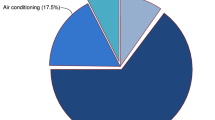Abstract
Green cognitive radio is a cognitive radio (CR) that is aware of sustainable development issues and deals with an additional constraint as regards the decision-making function of the cognitive cycle. In this paper, it is explained how the sensors distributed throughout the different layers of our CR model could help on taking the best decision in order to best contribute to sustainable development.













Similar content being viewed by others
Notes
Since sensors are the heart of this paper, they will be noted for the rest of the paper in italic letters
References
United Nations (1987) Report of the world commission on environment and development. In: General assembly resolution 42/187, 11 December 1987. Retrieved 2007-04-12
Palicot J, Roland C (2005) On the use of cognitive radio for decreasing the electromagnetic radiations. In: URSI 05, XXVIII general assembly, New Delhi, India, 23–29 October 2005
SUPELEC (2009) Next generation wireless green networks workshop. http://www-prod-gif.supelec.fr/d2ri/flexibleradio/Workshops/Greenworkshop/index.html
Palicot J (2009) Cognitive radio: an enabling technology for the green radio communications concept. In: IWCMC’09, Leipzig, Germany
Mitola J (2000) Cognitive radio. PhD dissertation, Royal Inst. of Tech., Sweden
Mitola J (1995) The software radio architecture. IEEE Commun Mag 33(5):26–38
Palicot J, Moy C, Hachemani R (2009) Multilayer sensors for the sensorial radio bubble. Phys Commun 2(1–2):151–165
Mitola III J, Maguire Jr GQ (1999) Cognitive radio: making software radios more personal. IEEE Pers Commun 6(4):13–18
Palicot J, Zhang X, Leray P, Moy C (2010) Cognitive radio and green communications: power consumption consideration. In: IRSSP conference, Sofia, Bulgarian
Delorme J, Nafkha A, Leray P, Moy C (2009) New OPBHWICAP interface for realtime partial reconfiguration of FPGA. In: International conference on reconfigurable computing and FPGAs
Gupte A, Jones P (2009) Hotspot mitigation using dynamic partial reconfiguration for improved performance. In: International conference on reconfigurable computing and FPGAs
McNally D (1994) The vanishing universe, p 208. Cambridge University Press, Cambridge, UK. ISBN 0521450209
Percy J (1998) Preserving the astronomical windows by/for education and culture. In: ASP conference series, vol 139
http://www.nrao.edu/index.php/learn/radvioastronomy/interference
Zhang H (2008) Cognitive radio for green communications and green spectrum. In: COMNETS 08 co-located with CHINACOM 08, 25–27 August 2008, Hangzhou, China
Mahesh R, Vinod AP, Moy C, Palicot J (2008) A low complexity reconfigurable filter bank architecture for spectrum sensing in cognitive radios. In: CROWNCOM 2008, Singapore
Jouini W, Moy C, Palicot J (2012) Decision making for cognitive radio equipment: analysis of the first 10 years of exploration. In: EURASIP journal on wireless communications and networking, vol 2012, p 26
He A, Kyung KB, Newman TR, Gaeddert J, Kyouwoong K, Menon R, Morales-Tirado L, Neel JJ, Zhao Y, Reed JH, Tranter WH (2010) A survey of artificial intelligence for cognitive radios. IEEE Trans Veh Technol 59(4):1578–1592
Jouini W, Ernst D, Moy C, Palicot J (2010) Upper confidence bound based decision making strategies and dynamic spectrum access. In: International communication conference, ICC’10, Cape Town, South Africa
Wang B, Wu Y, Liu KJR (2010) Game theory for cognitive radio networks: an overview. Comput Netw 54:2537–2561
Azamasab E, Kempter R, Patwari N, Farhang-Boroujen B (2007) Filterbank multicarrier and multicarrier CDMA for cognitive radio systems. In: Cognitive radio oriented wireless networks and communications, 2007. CrownCom 2007
Skrzypczak A, Palicot J, Siohan P (2012) OFDM/OQAM modulation for efficient dynamic spectrum access. Int J Commun Netw Distrib Syst 8(3/4):247–266
Renfors M, Siohan P, Farhang-Boroujeny B, Bader F (2010) Filter bank for next generation multicarrier wireless system. In: Eurasip journal on advances on signal processing (ASP), vol 2010, p 2
Zhang H, Le Ru yet D, Terre M (2009) Spectral efficiency analysis in OFDM and OFDM/OQAM based cognitive radio networks. In: Vehicular technology conference, 2009. VTC Spring
Palicot J, Louet Y, Hussain S, Zabre S (2008) Frequency domain interpretation of power ratio metric for cognitive radio systems. In: Proceedings of IET communications journal, vol 2, pp 783–793
Hall PS, Vetterlein SJ (1990) Review of radio frequency beamforming techniques for scanned and multiple beam antennas. In: Microwaves, antennas and propagation, IEE proceedings H, vol 137, issue 5
Litva J (1996) Digital beamforming in wireless communications. In: Artech house mobile communications
Wang H, Jouini W, Nafkha A, Palicot J, Cardoso L, Debbah M (2010) Blind standard identification with bandwidth shape and GI recognition using USRP platforms and SDR4all tools. In: 5th international ICST conference on cognitive radio oriented wireless networks (Crown’Com), Cannes, France
Socheleau F, Houcke S, Ciblat P, Abdeldjalil A (2011) Cognitive OFDM system detection using pilot tones second and third-order cyclostationarity. Signal Process 91(2):252–268
Author information
Authors and Affiliations
Corresponding author
Rights and permissions
About this article
Cite this article
Palicot, J. Cross-layer sensors for green cognitive radio. Ann. Telecommun. 67, 171–180 (2012). https://doi.org/10.1007/s12243-012-0292-0
Received:
Accepted:
Published:
Issue Date:
DOI: https://doi.org/10.1007/s12243-012-0292-0




